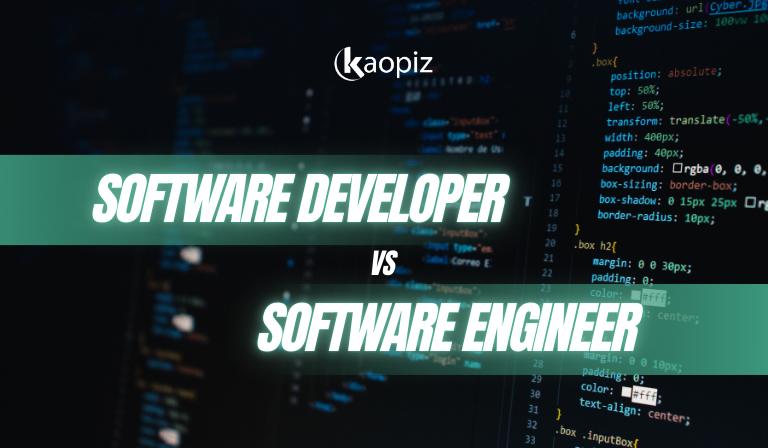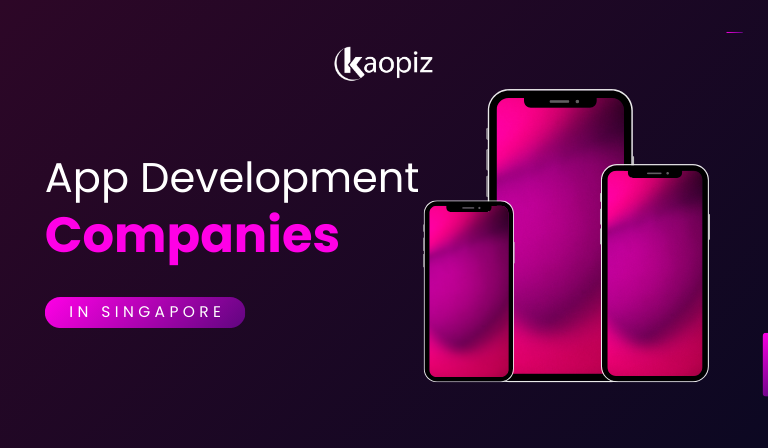15+ Web Development Platforms for Building Websites & Apps [2025 Guide]
Every day, 252,000 new websites are created, intensifying the competition for online visibility and traffic (Source: Siteefy). With more consumers spending their time online, having a visually appealing, user-friendly, and SEO-optimized website is crucial for businesses to stand out. A solid web development strategy is key to boosting organic traffic and ensuring a strong digital presence.
In this guide, we explore the top 15+ web development platforms for 2025, helping you choose the best tools for building successful websites and web apps.
Table of Contents
- What Are Web Development Platforms?
- Top 15+ Web Development Platforms for 2025 (List + Pros/Cons + Best Use Cases)
- How to Choose the Best Web Development Platform for Your Business
- Web Development in Singapore (Local Tips & Considerations)
- Why Kaopiz is the Trusted Partner for Web Development Solutions
- Conclusion
- FAQs
What Are Web Development Platforms?
Web development platforms are tools that provide everything needed to create, deploy, and maintain websites or web applications. They range from no-code solutions to advanced frameworks, catering to both non-technical users and developers.
These web application development platforms typically include design tools, pre-built templates, and integrated services like hosting, allowing users to focus on content and functionality rather than the technical aspects of coding. They simplify website development, making it faster and more accessible, and allowing businesses to build sites that are scalable and optimized for performance.
Top 15+ Web Development Platforms for 2025 (List + Pros/Cons + Best Use Cases)
With so many options available, choosing the right web development platform can be overwhelming. In this section, we cover the top 15+ best software development platforms for 2025, highlighting their pros, cons, and best use cases to help you select the best tool for your project.
No-Code Platforms
According to The Business Research Company, the no-code development platform market has seen rapid growth, expanding from $22.11 billion in 2023 to $28.11 billion in 2024, driven by a 27.1% annual growth rate. This surge is largely due to the increasing need for rapid programs for app development, cloud adoption, and the growing demand for third-party integration, helping businesses reduce IT backlogs.
By 2028, the market is expected to reach $73.84 billion, with a projected 27.3% CAGR, fueled by digital transformation, e-commerce growth, mobility needs, and the rise of hyper-automation.
Let’s explore some of the most popular no-code platforms for web development in 2025, each offering unique features and benefits that cater to different business needs.
Wix
Wix is one of the best platforms for web development, known for its user-friendly interface and drag-and-drop functionality. It allows users to build stunning websites without any coding knowledge. It offers a wide range of pre-designed templates, which can be customized easily to suit various industries and needs.
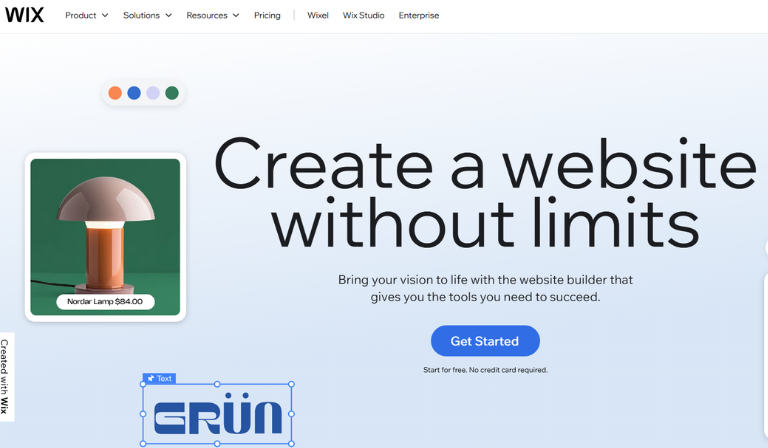
Wix Pros and Cons:
| Pros | Cons |
|---|---|
| User-friendly drag-and-drop editor | Limited flexibility for highly customized designs |
| Extensive selection of professional templates | Higher-tier plans can be costly for small businesses |
| Built-in SEO tools to improve search engine ranking | Some advanced features may require additional apps |
| AI-powered design assistance (Wix ADI) for faster setup |
Pricing Plans (Billed Annually):
- Light: $17/month
- Core: $29/month
- Business: $36/month
- Business Elite: $159/month
Best Use Cases:
- Personal websites, small businesses, portfolios, blogs
- Launching an online store without needing a developer (thanks to integrated e-commerce capabilities)
Squarespace
Squarespace enables users to create professional-looking websites with ease. Known for its sleek, modern design templates, the platform offers a simple drag-and-drop interface, which allows users to design and customize their websites while providing the flexibility to grow and scale.
Squarespace Pros and Cons:
| Pros | Cons |
|---|---|
| Beautiful, professionally designed templates | Limited customization compared to other platforms |
| User-friendly drag-and-drop interface | No free plan (only a 14-day trial) |
| Integrated e-commerce features | Fewer third-party integrations compared to competitors |
| Built-in SEO tools to improve search engine visibility | Can be pricey for small businesses |
| 24/7 customer support with live chat |
Pricing Plans (Billed Annually):
- Personal Plan: $16/month
- Business Plan: $23/month
- Basic Commerce: $27/month
- Advanced Commerce: $49/month
Best Use Cases:
- Creatives, photographers, small businesses, and bloggers needing a professional-looking website quickly
- E-commerce businesses looking for an easy-to-manage store with integrated payment options and inventory management
Webflow
Webflow is one of the best web development platforms designed for web designers and developers who want complete control over their website’s design without writing code. Unlike other no-code tools, Webflow offers advanced customization options that allow for pixel-perfect designs and complex animations, making it ideal for those who want more flexibility.

Webflow Pros and Cons:
| Pros | Cons |
|---|---|
| Full design control without coding | Steep learning curve for beginners |
| Responsive design tools for mobile, tablet, and desktop views | Limited template selection compared to other platforms |
| Built-in CMS for managing dynamic content | Higher pricing plans compared to some other no-code tools |
| Advanced interactions and animations | No built-in email hosting |
| E-commerce capabilities with integrated payment solutions |
Pricing Plans (Billed Annually):
- Starter Plan: Free
- Basic Plan: $14/month
- CMS Plan: $23/month
- Business Plan: $39/month
- Enterprise Plan: Custom pricing
Best Use Cases:
- Web designers, agencies, and creative professionals who need complete control over their website’s design and functionality
- Businesses seeking advanced customization and e-commerce features without relying on heavy coding
Bubble
Bubble allows users to build fully functional web applications without writing any code. It’s designed for entrepreneurs, startups, and anyone looking to build complex web apps quickly. Bubble enables users to design custom workflows, manage databases, and integrate APIs—all through an intuitive, visual interface.
Bubble Pros and Cons:
| Pros | Cons |
|---|---|
| Fully customizable web applications without coding | Steep learning curve for beginners |
| Visual interface with drag-and-drop functionality | Can be slow with large, complex apps |
| Built-in database and API integration | Limited scalability for very large applications |
| No need for external hosting, Bubble handles everything | Performance can degrade with high traffic |
| Strong community and plenty of tutorials for support | Limited support for advanced integrations and custom code |
Pricing Plans (Billed Annually):
- Free Plan: $0/month
- Starter Plan: $29/month
- Growth Plan: $119/month
- Team Plan: $349/month
- Enterprise Plan: Custom pricing
Best Use Cases:
- Building web applications, MVPs, and prototypes without the need for coding
- Startups, entrepreneurs, and non-technical founders who want to validate ideas quickly or create custom solutions without hiring a developer
Adalo
Adalo is one of the no-code platforms for web development, designed specifically for building mobile and web applications. It allows users to create fully functional apps with a simple drag-and-drop interface. This platform is known for its ease of use and powerful features.

Adalo Pros and Cons:
| Pros | Cons |
|---|---|
| Easy-to-use drag-and-drop interface | Limited design flexibility compared to other platforms |
| Built-in database management and real-time data updates | Can be limiting for complex app functionalities |
| Supports mobile and web app development from a single platform | Some advanced features may require external integrations |
| Offers integration with third-party tools and APIs | Performance can degrade with very large apps |
| No need for external hosting, Adalo provides hosting services |
Pricing Plans (Billed Annually):
- Free Plan: $0/month
- Starter Plan: $36/month
- Professional Plan: $52/month
- Team Plan: $160/month
- Business Plan: $200/month
Best Use Cases:
- Non-technical users looking to create mobile apps, web apps, or prototypes quickly
- Startups and entrepreneurs who want to test their ideas or build MVPs without hiring developers
CMS & E-commerce
The global CMS market is projected to reach $23.17 billion by 2025, driven by businesses seeking more efficient ways to create, manage, and deliver digital content (Statista).
In parallel, e-commerce continues to surge, with the industry expected to reach $6 trillion by 2025. This growth is largely fueled by B2C e-commerce, which has seen significant investments in platforms like Shopify and Magento.
Interestingly, B2B e-commerce, although historically smaller in comparison, is expected to see platform investments rise to $4.2 billion by 2025, signaling a shift in focus toward enhancing B2B digital commerce.
In this section, we explore the top CMS and e-commerce web development platforms to help you choose the best one.
WordPress
WordPress is the world’s most popular CMS, powering over 40% of websites globally. It’s an open-source platform known for its ease of use, flexibility, and vast ecosystem of plugins and themes. Whether you’re building a personal blog, a business website, or an e-commerce store, WordPress offers powerful tools to manage and grow your online presence.
WordPress Pros and Cons:
| Pros | Cons |
|---|---|
| Highly customizable with thousands of plugins and themes | Requires regular updates for core, themes, and plugins |
| User-friendly interface for beginners and experienced users | Vulnerable to security risks due to its popularity |
| Built-in SEO tools and plugins like Yoast SEO | Performance can degrade with more plugins and complex features |
| Scalable for websites of all sizes, from blogs to enterprises | Can become slow without proper optimization |
| Strong community support with resources and tutorials |
Pricing Plans (Billed Annually):
- Personal Plan: $4/month
- Premium Plan: $8/month
- Business Plan: $25/month
- Commerce Plan: $45/month
- Enterprise Plan: Custom pricing
Best Use Cases:
- Small businesses, bloggers, non-profits, and e-commerce stores are looking for an easy-to-manage, flexible solution
- Personal websites and large, complex corporate sites are due to their scalability
Drupal
Drupal is a powerful open-source CMS used by large organizations, governments, and enterprises to build complex and highly customizable websites. This is one of the robust enterprise web development platforms that offers deep customization through its modular system, making it suitable for developers who need to build dynamic websites with tailored functionalities.
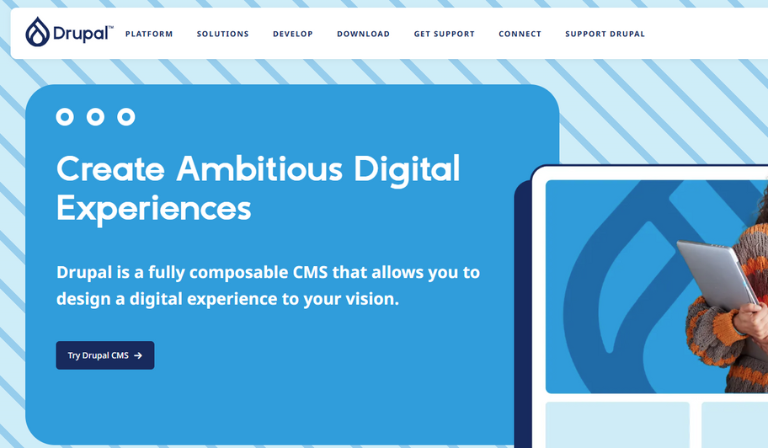
Drupal Pros and Cons:
| Pros | Cons |
|---|---|
| Highly customizable with extensive modules and themes | Steep learning curve, requires technical expertise |
| Scalable, can handle high-traffic websites and complex apps | Complex setup process, may require a dedicated developer |
| Robust security features, ideal for government and enterprise websites | Fewer out-of-the-box themes compared to other platforms |
| Built-in multilingual support for easy content management | Can be resource-intensive and require optimization |
Pricing Plans: Drupal is free to download and use. However, businesses may incur costs for hosting, themes, modules, and professional development if they require custom features or support.
Best Use Cases:
- Large-scale websites and complex applications
- Enterprise-level content management systems
- Organizations needing a highly secure, scalable solution with advanced customization and multilingual capabilities
Shopify
Shopify is one of the leading e-commerce web development platforms that allows businesses to set up and manage online stores effortlessly. With a wide range of templates, apps, and integrations, Shopify makes it easy for users to build professional e-commerce websites and scale as their business grows.
Shopify Pros and Cons:
| Pros | Cons |
|---|---|
| User-friendly with easy setup and intuitive interface | Transaction fees unless using Shopify Payments |
| Comprehensive e-commerce features (payment gateway, inventory management) | Some advanced customizations may require coding knowledge |
| Scalable for businesses of all sizes, from startups to large enterprises | Monthly fees can be expensive for smaller businesses |
| Mobile-optimized themes and apps for enhanced customer experience | Limited reporting in lower-tier plans |
| 24/7 customer support via chat, email, or phone |
Pricing Plans (Billed Annually):
- Basic Plan: $19/month
- Grow Plan: $49/month
- Advanced Shopify Plan: $299/month
- Shopify Plus: $2,300/month
Best Use Cases:
- Entrepreneurs looking to launch an online store with ease
- Small businesses and medium-sized companies want a simple, effective e-commerce platform
Magento
Magento is one of the powerful open-source web development platforms used by businesses worldwide to build scalable, feature-rich online stores. Known for its flexibility, Magento allows developers to create custom, complex e-commerce solutions tailored to specific business needs.
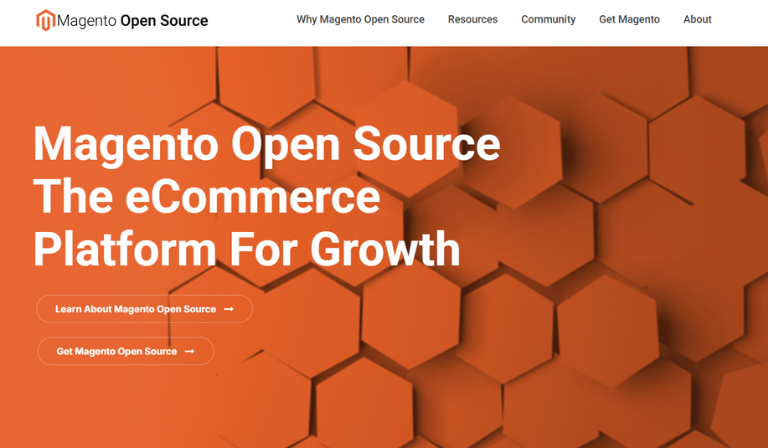
Magento Pros and Cons:
| Pros | Cons |
|---|---|
| Highly customizable with full control over design and features | Requires technical expertise (PHP, HTML, database management) |
| Scalable to handle high traffic and complex product catalogs | Complex setup and maintenance, can be resource-intensive |
| Powerful built-in SEO features to enhance search engine rankings | Higher costs for hosting, development, and premium features |
| Extensive third-party integrations with payment gateways, shipping carriers, etc. | Can be overkill for small businesses with basic e-commerce needs |
| Active and large developer community for support and resources |
Pricing Plans (Billed Annually):
- Magento Open Source: Free
- Magento Commerce: Starts at $22,000/year
- Magento Commerce Cloud: Custom pricing
Best Use Cases:
- Medium to large businesses with complex e-commerce needs
- Companies expecting high growth and requiring extensive customization
- Businesses needing robust third-party integrations and scalability
Web Frameworks
A web framework is a software framework designed to aid the development of web applications, simplifying the process by automating repetitive tasks such as routing, session management, and authentication.
As of 2024, Node.js has overtaken React.js to become the most used web framework, with 40.8% of developers reporting its use, compared to 39.5% for React.js, according to Statista. Let’s discover some of the popular web development frameworks in 2025.
React
React is a widely used JavaScript library (which is one of the web application languages) for building dynamic and interactive user interfaces, particularly for SPAs. Developed by Facebook and released as an open-source project, React allows developers to create reusable components, making it easy to build large-scale applications with complex user interactions.
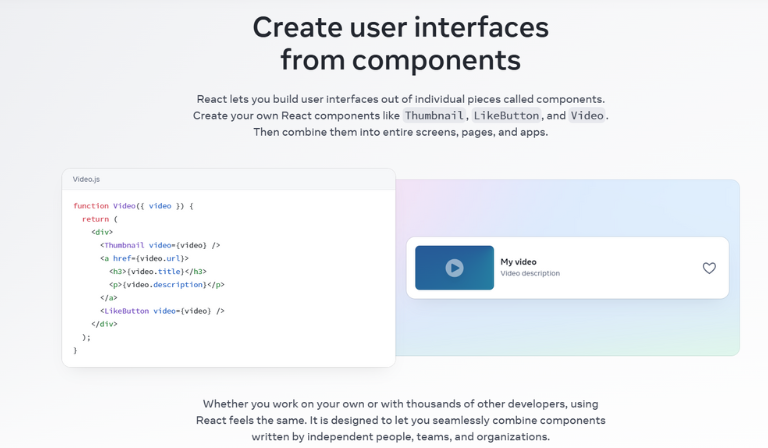
React Pros and Cons:
| Pros | Cons |
|---|---|
| Reusable components for scalable and maintainable UIs | Frequent updates may lead to compatibility issues |
| Virtual DOM enhances performance by rendering only changed components | React is primarily a library for the view layer, requiring additional tools for full functionality |
| Strong community support with extensive resources and libraries | Requires understanding of modern JavaScript (ES6+) and concepts like JSX and component lifecycles |
| Flexible and can be integrated with various back-end technologies |
Pricing Plans: React is open-source and free to use, but businesses may incur costs for hosting, development, and third-party integrations.
Best Use Cases:
- Building dynamic, interactive user interfaces and SPAs
- Projects like social media platforms, e-commerce sites, and large-scale web applications
Angular
Angular is a robust, open-source web application framework developed and maintained by Google. It is designed to make it easier to build dynamic, large-scale, and feature-rich web applications.
Angular Pros and Cons:
| Pros | Cons |
|---|---|
| Two-way data binding automatically syncs model and view | Steep learning curve for beginners |
| Modular structure for reusable components and services | Performance can suffer for complex apps or heavy updates |
| Comprehensive framework with tools for routing, state management, and forms | Verbose syntax, which can reduce development speed |
| Excellent tooling support with Angular CLI | Larger file size, impacting load times and performance |
| Cross-platform development support (web, mobile, desktop) |
Pricing Plans: Angular is free and open-source, with no direct cost for using the framework. However, businesses may incur costs for hosting, development, and third-party tools.
Best Use Cases:
- Large-scale applications and enterprise-level projects
- Dynamic web apps requiring extensive features, modularity, and strong tooling support
- CRMs, project management tools, and real-time data applications
Vue.js
Vue.js is a progressive, open-source JavaScript framework used for building dynamic and interactive user interfaces. Unlike other frameworks, Vue is designed to be incrementally adoptable, meaning you can integrate it into a project step by step, making it ideal for both small enhancements and full-scale applications.
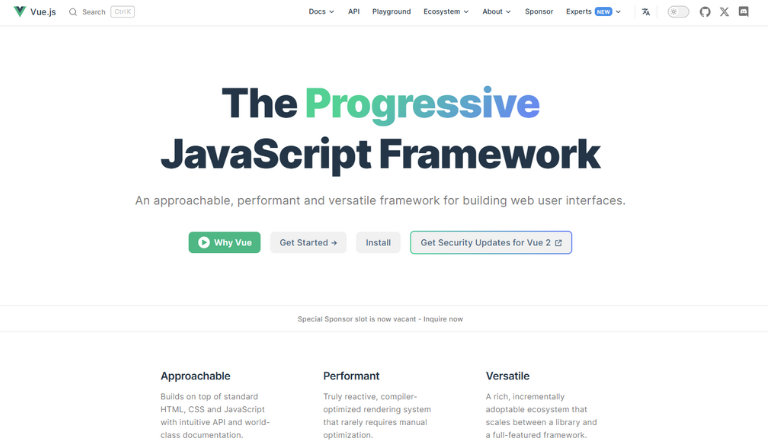
Vue.js Pros and Cons:
| Pros | Cons |
|---|---|
| Easy to learn and integrate into existing projects | Smaller ecosystem compared to React or Angular |
| Efficient reactivity system with automatic updates to the UI | Limited corporate backing and fewer resources |
| Lightweight and fast, improving performance | Not as widely adopted, fewer job opportunities for Vue developers |
| Highly flexible for both simple and complex applications | Over-flexibility can lead to inconsistent coding practices |
| Strong community support and growing ecosystem |
Pricing Plans: Vue.js is free and open-source. However, businesses may incur costs for hosting, development, and third-party integrations.
Best Use Cases:
- Building lightweight, fast, and responsive web applications
- Single-page applications and PWAs
- Projects that require high performance and quick load times
Node.js
Node.js is a powerful, open-source JavaScript runtime built on Chrome’s V8 JavaScript engine. It allows developers to run JavaScript on the server side, enabling the development of scalable and high-performance applications. Node.js is designed for building fast, data-intensive, and real-time applications.
Node.js Pros and Cons:
| Pros | Cons |
|---|---|
| Non-blocking, event-driven architecture for high concurrency | Steep learning curve for developers unfamiliar with asynchronous programming |
| Fast execution with Chrome’s V8 JavaScript engine | Single-threaded, which may limit performance for CPU-intensive tasks |
| Large ecosystem with thousands of packages available through NPM | Not suited for CPU-heavy operations like video processing |
| Ideal for building real-time applications (e.g., chat apps, gaming platforms) | Callback hell can make the code harder to maintain in large projects |
| JavaScript is used on both the client and server side, promoting full-stack development |
Pricing Plans: Node.js is free and open-source, with no direct cost for using the runtime.
Best Use Cases:
- Building real-time web applications like chat apps, online gaming platforms, and collaborative tools
- API development and microservices architectures
Django
Django is a high-level, open-source Python web framework that promotes rapid development and clean, pragmatic design. It was designed to make it easier to build complex, data-driven websites and applications while encouraging best practices like code reusability and scalability.
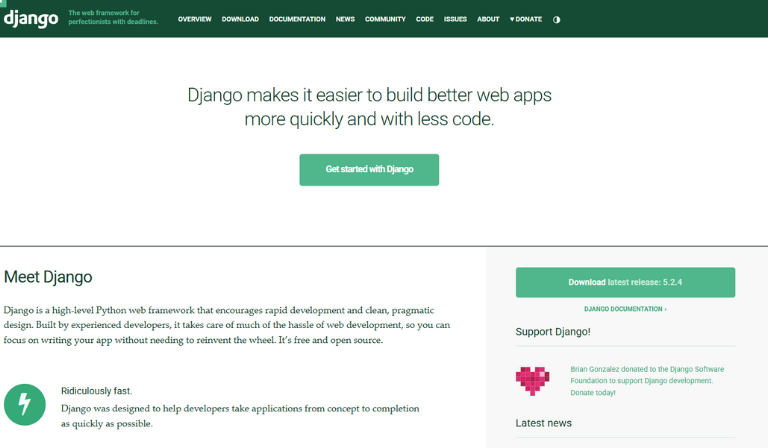
Django Pros and Cons:
| Pros | Cons |
|---|---|
| “Batteries-included” framework with built-in tools for development | Can be overly complex for simple projects |
| Highly secure, with built-in protection against common threats | Performance can be slower than some lighter frameworks |
| Excellent for rapid development with reusable components | Not as flexible as micro-frameworks for custom solutions |
| Scalable and suitable for large, data-driven applications |
Pricing Plans: Django is free and open-source, with no direct cost for using the framework. However, businesses may incur costs for hosting, development, and third-party integrations.
Best Use Cases:
- Building large, data-driven applications
- Enterprise-level applications requiring high security and scalability
Tools & API Platforms
Tools & API platforms are essential for developing, managing, and integrating APIs and other backend services in web applications. These platforms provide developers with the necessary tools to create, test, and monitor APIs, ensuring seamless communication between systems.
Postman
Postman is a popular API development and testing platform that simplifies the process of building, testing, and managing APIs. It is widely used by developers to automate API testing and streamline the development workflow. Postman allows users to create API requests, validate responses, and easily integrate APIs into their applications.
Postman Pros and Cons:
| Pros | Cons |
|---|---|
| Easy-to-use interface for creating and managing API requests | Performance issues with large, complex test suites |
| Automated testing for validating API functionality | Requires local installation for full functionality |
| Supports multiple API formats (REST, SOAP, GraphQL, WebSocket) | Limited enterprise features in the free version |
| Collaboration features for sharing collections and environments |
Pricing Plans (Billed Annually):
- Free Plan: $0/month
- Basic Plan: $12/month
- Professional Plan: $29/month
- Enterprise Plan: Custom pricing
Best Use Cases:
- API developers needing to automate testing, manage documentation, and streamline API integration
- Small teams and large enterprises require robust API management features
Swagger
Swagger is a powerful suite of tools for designing, building, and documenting RESTful APIs. It offers a set of open-source tools that simplify the API lifecycle, including Swagger UI, which allows users to visualize and interact with API endpoints, and Swagger Editor, which enables developers to design APIs with the OpenAPI Specification (formerly known as Swagger Specification).
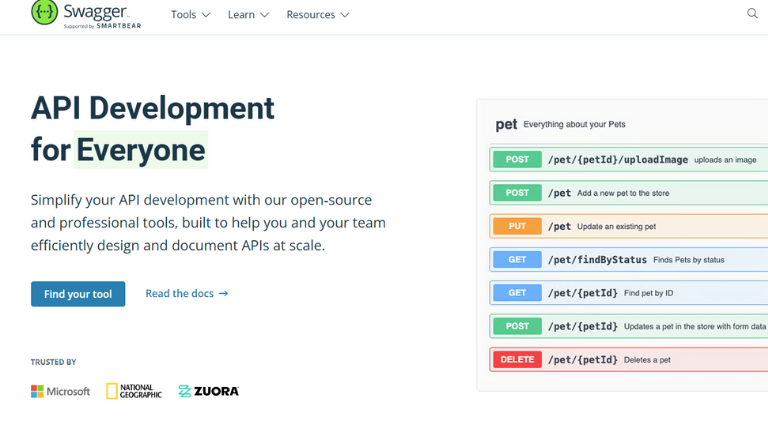
Swagger Pros and Cons:
| Pros | Cons |
|---|---|
| Interactive API documentation with Swagger UI | Complex setup for large applications |
| Easy integration with existing frameworks and tools | Limited support for non-REST APIs |
| Open-source and free to use with strong community support | Requires understanding of the OpenAPI Specification |
| Standardized format for clear and structured API documentation | UI customization can be limited for some use cases |
| Extensive ecosystem of tools like Swagger Editor, Swagger Codegen, and SwaggerHub |
Pricing Plans (Billed Annually):
- Swagger Open Source: Free
- SwaggerHub: Starts at $75/month
- Swagger Enterprise: Custom pricing
Best Use Cases:
- Teams developing RESTful APIs that require clear, interactive documentation
- Large projects, open-source teams, and businesses needing comprehensive API lifecycle management
- Projects requiring design, testing, documentation, and deployment of APIs
How to Choose the Best Web Development Platform for Your Business
In this section, we cover the factors you need to consider when choosing a platform and help you decide the best platform for different business models like e-commerce, corporate websites, and web applications.
Factors to Consider When Choosing Web Development Platforms
- Business Goals: Understand whether you’re building a simple site, an e-commerce store, or a complex app. Different platforms cater to different needs.
- Ease of Use: Choose a platform based on the skillset of your team—Wix for beginners or React for more technical applications.
- Scalability: Ensure the platform can grow with your business. Shopify and Magento work well for e-commerce, while Node.js and Django support more complex applications.
- Customization: Consider whether you need full flexibility (e.g., WordPress or Webflow) or a simpler, ready-made solution (e.g., Wix).
- Security: Look for built-in security features, especially if dealing with sensitive data, including SSL encryption and payment protection.
- Cost: Factor in the total cost, including hosting, licensing, and any additional tools or features required.
- SEO and Performance: A good platform should help with SEO and ensure fast load times. Platforms like WordPress and Webflow are SEO-friendly.
Choosing for E-commerce, Corporate Websites, Web Apps
- E-commerce
For online stores, Shopify is ideal for small businesses, offering easy setup and built-in payment systems. For larger stores with more customization needs, Magento is a powerful choice. WooCommerce integrates well with WordPress and is great for smaller stores.
- Corporate Websites
WordPress is great for corporate websites due to its flexibility and content management tools. For larger enterprises, Drupal offers greater customization and security. Squarespace and Wix are simpler options for smaller businesses.
- Web Apps
For interactive web apps, React and Angular are excellent choices. React is best for dynamic user interfaces, while Angular suits enterprise-level apps. Django is ideal for secure, scalable web apps with Python.
Web Development in Singapore (Local Tips & Considerations)
Singapore has become a leading hub for web development in Southeast Asia, offering a highly skilled workforce and a growing digital ecosystem. Whether you’re a local startup or an international company, understanding key factors will help you make informed decisions when choosing web development companies in Singapore.
Key considerations for Singapore businesses:
- Talent and Expertise: Singapore has a highly skilled tech workforce, with agencies offering services from full-stack development to custom web solutions. Companies like Kaopiz cater to businesses of all sizes.
- Digital Transformation: The government supports digital initiatives, making it easier for businesses to adopt modern web technologies and enhance customer experience.
- Security and Data Protection: With strong data protection laws, security is a priority for web development in Singapore, especially for the e-commerce and finance sectors.
- Mobile-First Approach: With high mobile usage, websites must be mobile-optimized. UX/UI design is also a key focus, ensuring smooth navigation across devices.
Some popular platforms in Singapore are WordPress, Shopify, React, Angular, Node.js, and Magento. Moreover, the cost of web development in Singapore varies based on complexity and website design. Simple websites can range from SGD 2,000 to SGD 5,000, while complex projects may start at SGD 10,000 or more.
Why Kaopiz is the Trusted Partner for Web Development Solutions
Kaopiz is one of your trusted software development companies in Singapore for high-quality, tailored web app development. With extensive experience, a skilled team, and a focus on delivering reliable, scalable, and secure websites, we help businesses of all sizes build custom web development solutions and achieve their digital goals.
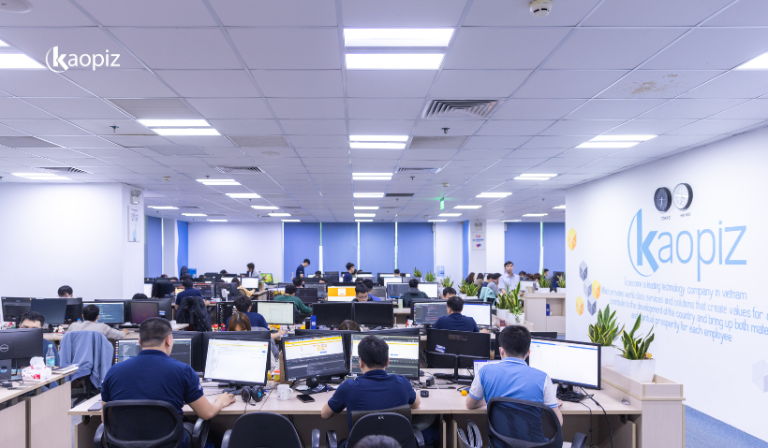
- Expertise Across Platforms and Technologies: We offer expertise in various platforms and technologies such as React and Node.js, ensuring the right solution for your business needs.
- Comprehensive Services: From custom design and responsive development to API integrations and security, we provide end-to-end web platforms with AI integration to ensure a seamless experience.
- Performance and Scalability: We focus on creating fast, responsive, and scalable websites that grow with your business, ensuring optimal performance even as traffic increases.
- Proven Success: With over 500 projects and a track record of satisfied clients, Kaopiz has earned a reputation for delivering high-quality, innovative web solutions on time and within budget.
- Client-Focused Approach: We prioritize our clients’ needs, working closely to understand business objectives and deliver results that align with their vision. Transparency and customer satisfaction are key to our success.
Choose Kaopiz for a trusted, reliable partner to build your next web development project.
Conclusion
Choosing the right web development platform is crucial for the success of your online presence. Whether you’re building a simple website, an e-commerce store, or a complex web application, understanding your business needs and selecting the right platform can make all the difference.
As you explore the various top web development platforms available, remember that scalability, customization, and performance are key factors in making an informed choice. By partnering with experienced developers and agencies like Kaopiz, you can ensure your affordable web development in Singapore not only meets your current needs but is also ready for future growth.
FAQs
- What Are the Best Platforms for Building E-commerce Websites?
- The best platforms for building e-commerce websites include Shopify, Magento, and WooCommerce. Shopify is ideal for small-to-medium businesses due to its ease of use and integrated features. Magento is perfect for larger businesses requiring extensive customization and scalability. WooCommerce integrates seamlessly with WordPress and is perfect for small to medium-sized e-commerce stores.
- Can I Build a Web App without Coding?
- Yes, you can build a web app without coding using no-code platforms like Bubble, Adalo, and Webflow. These platforms offer drag-and-drop interfaces and pre-built templates, making it easier for non-technical users to create fully functional web applications without writing any code.
- Which Platform Is Best for Scalability?
- For scalability, Node.js, React, and Magento are excellent choices. Node.js and React offer powerful frameworks for building high-performance, scalable web apps and real-time applications. Magento, on the other hand, is ideal for e-commerce websites that need to scale efficiently as your business grows.
- What Is the Cheapest Way to Build a Website in Singapore?
- The cheapest way to build a website in Singapore is by using Wix or WordPress. Both platforms offer affordable plans with essential features for small businesses or personal websites. Wix is particularly user-friendly, while WordPress offers more flexibility and customization options, especially if you use cheap hosting services.
- What Are the Most Popular Web Development Platforms in 2025?
- In 2025, the most popular web development platforms include React, WordPress, Shopify, and Node.js. React and Node.js are favored for dynamic and scalable web applications, while WordPress continues to dominate for content-driven websites. Shopify remains the top choice for e-commerce businesses due to its simplicity and powerful built-in features.
















